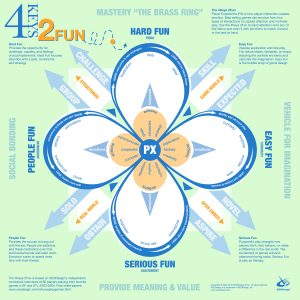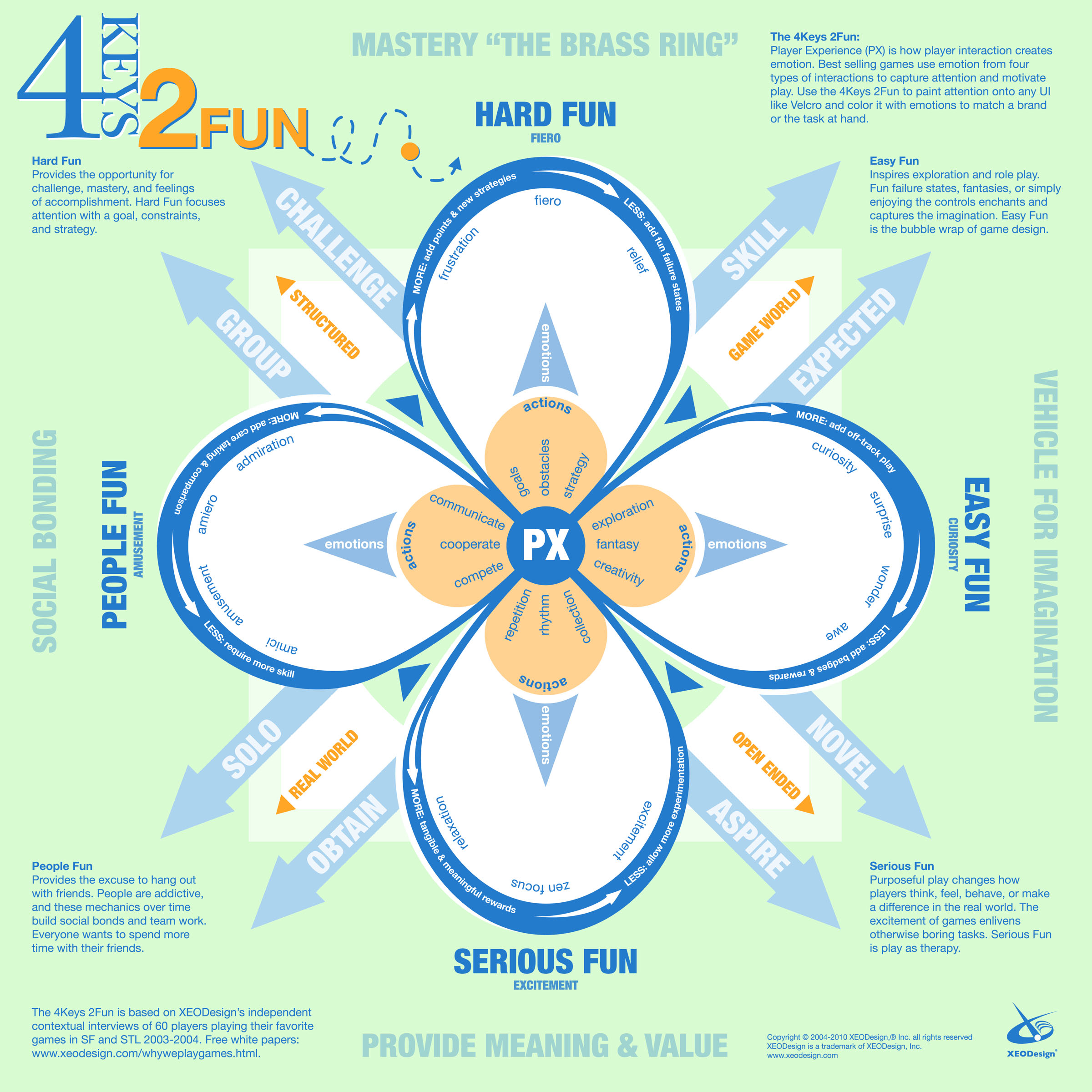What’s the difference between a boring tool or game, and an engaging one? For something to be engaging, it needs to be easily understandable, and appealing; it needs to provide various different mechanics that appeal to different people, without forcing all of them on anyone. In a word, it needs engagement design, the concious act of designing something to be engaging. Some of you may have heard of this approach by its old name, gamification.

I don’t like to talk about gamification because it gives the wrong impression that everything needs to become a game, or game-like. That is not the point. Everything should become engaging, because people deserve better than poorly designed, boring tools.
But what appeals to one person does not appeal to everyone else. Some people enjoy competition, others enjoy challenges they can overcome, others want to just drift with an activity. It may be impossible to create a single product that appeals to everyone. Most likely, several different products are needed. But modern digital technologies make it possible to embed many difference designs into a single product.
Let’s use an online course as an example. It contains some material that learners need to learn. Some may be motivated to learn the content to be able to apply it, others may not be. How should this online course be designed? Here I present just some general principles, as a comprehensive manual would be just that, a thick manual.
As people find the course, they need to be onboarded. They don’t yet know if they are interested, so it needs to be immediately obvious what the benefits might be and how to start. As people sign up for the course, the scaffolding phase begins. Its goal is to minimize the time that people feel they are not really productive or understanding what’s going on. Some have called this unhappy period the suck phase (since it sucks to do that). So the suck phase needs to be minimized by providing various scaffolding, support, tips, aids, and help, so that people can quickly become familiar and productive with the course and start gaining new knowledge and understanding. After this, the course needs to make it clear how students can achieve mastery, meaning in this case how they can complete the course, excel in it, and even go beyond the minimum results.
How to do this in practice? The Gamification MOOC by Pennsylvania University has all the details you need. Here are some summaries that are more fully explained in the course materials. These summaries are written by me, with my own emphasis and personal views, combining my own knowledge of learning, psychology, and design.
Will engagement design work in a business setting?
Before you start your design, analyze these four questions properly.
- Motivation: Will the new or altered behavior derive value?
- Meaningful choices: Are the activities interesting?
- Structure: Can you algorithmize the behavior of participants?
- Potential conflicts: Avoid tension with other motivational structures.
The design framework
If you decide to go forward with your engagement design, this is the overall framework you should take a look at and adapt to your needs.
- Define the business objectives. List and rank them. Consider only final objectives, not means to ends. Justify the objectives.
- Delineate target behaviors. What should participants do specifically? How do you measure those activities? What analytics or measurement tools will to bring to bear?
- Describe your players. Include the normal demographics as well as psychometrics (see below, section “Different people”).
- Devise activity loops. Engagement loops start with motivating to perform an action, then giving feedback that encourages for another action, improved from the previous attempt. Engagement loops should be short; feedback should be given as soon as possible. Progression loops describe how the process through the story arc happens. It can be a linear path, many parallel paths, rhytmic loops, or any combinations of these.
- Don’t forget the fun. Fun needs to be understood widely as being in the flow (à Csíkszentmihályi), being engaged, enjoying oneself. Not just laughter.
- Deploy the appropriate tools. What’s important is that this is the last step. If you start by selecting a tool, you’re climbing the tree backwards. The tool needs to be chosen to best serve all that has been designed previously. In reality, this is often not possible, but it’s good to be aware of the limitations the tool will enforce and which will make the implementation of your design inferior.
Elements of gamification
Here are some often used elements in various gamification attempts. The bold ones are the PBL (points, badged, leaderboards), which are the easiest to implement and add, and which usually produce only minimal results. Good engagement design will take a broader look at what kinds of people it accommodates.
- Achievements
- Avatars
- Badges
- Boss fights
- Collections
- Combat
- Content Unlocking
- Gifting
- Leaderboards
- Levels
- Points
- Quests
- Social Graph
- Teams
- Virtual goods
Different people, different ways of fun

People are different and are drawn to different things. There are various ways of looking into that. One of the most comprehensive models is probably the Octalysis model, which identifies eight different areas of motivational components. 4keys2fun from xeodesign is a simpler alternative breakdown of different people and their ways of enjoying what they do.
However you analyze people, the point is that to make a product or service motivating, it should attract all kinds of people, meaning it needs to have elements from all motivational areas. But beware that as some elements may motivate some people, others will be put off by them. You cannot include all elements and force them on everyone. You need to identify what each participant responds positively to, and emphasize those elements, while removing the ones they do not enjoy. Practically:
Well designed engagement mechanics would tentatively present various elements to participants, see if they respond positively, and emphasize them more in the future. For example, an online course could offer the possibility to compare one’s scores to others, and for the participant tries that and explores those scores further, more competitive and challenge oriented mechanics could be added. Accordingly, if the participant passes the opportunity and instead joins a discussion forum to share tips, making collaboration and peer help more visible and prominent will probably engage that participant more.
Some general design principles
Engagement design (or gamification) is design, meaning good design practices are useful. Good design is often multidisciplinary, it is participatory, and it is iterative. And it takes time. Having a good designer or external facilitator will help achieve better results, when designing your next product, be it an online course, a game, a productivity tool, or something else.
I myself have worked extensively with teachers, and developed Edukata, a model for teachers to arrange participatory design workshops successfully.
The magic circle
And no matter the analysis methods and elements you employ, at the end of the day, there is only one thing that determines whether what you’ve designed is engaging or not: the participant’s experience. The magic circle is a useful concept here. It refers to the feeling of being in a different place, where normal rules of everyday life don’t apply. In the magic circle, you can play, you can experiment, you can act differently. Because it’s not severe, it’s not fatal. Because, in the magic circle (or indeed, in any game), it’s make-believe. If you win or not, or succeed or fail, only matters to you and others who are in the magic circle. Not the outside world.
This is not to say that a designed product can’t be serious or have real consequences. But the participant experience has to lift that seriousness away, and allow them to experiment, take risks, make choices, see the consequences, adapt their behavior, and retry. Failures can’t end the interaction, but rather lead to renewed, improved attempts.

[…] Could gamification help us to develop random facilitation? Here is what Tarmo Toikkanen says in his blog. […]